The 2020 NWSL Challenge Cup brought us a Sky Blue team in the midst of massive changes. The team performed better than expected, debatably outplaying the Chicago Red Stars in their semi-final loss. Through analysis, we have found a large shift in attacking tactics to a more possession-based style. This scout report will look at exactly how Sky Blue has changed.
Background
Having not qualified for the playoffs since 2013, Sky Blue have been widely known to underperform on the pitch. A major and well-documented reason for this is a negative team culture stemming from club mismanagement. This led the club to finish in the bottom half of the table every year since their 4th place finish in 2013.
The 2019 season appears to be the end of a dark time for the club. Although Sky Blue saw three head coaches take the helm during the campaign, a sense of positivity and forward direction arrived with Freya Coombe taking over as interim manager for the last five matches of the season.
Heading into the 2020 off-season, the First Lady of New Jersey Tammy Murphy announced that she would be taking an “active role” in the club and took immediate steps to create improvements. This came in the form of revamping the administerial aspects of the club, improving player housing and adding staff to the club payroll.
Additionally, the club have improved Sky Blue’s notorious training facilities with an agreement to share facilities with the New York Red Bulls. With these off-the-field improvements coming thick and fast, the club did not hesitate to do the same for the squad as well.
2020 Off-season
In December, Coombe was announced as permanent head coach and she quickly set to reshape the squad. This came in the form of: Acquiring forward Ifeoma Onumonu from OL Reign, Mallory Pugh from the Washington Spirit, McCall Zerboni from the North Carolina Courage and Midge Purce from The Portland Thorns. Additionally, central midfielder Jennifer Cudjoe became a central part of the squad after joining the team through an open tryout.
This massive shift in player personnel along with a new tactical philosophy from Coombe led to stark changes in the team’s playing style. A new focus on possession was immediately evident with the team moving from 7th in 2019 to 1st in 2020 in passes per 90’ with 360.12 and 430.20 respectively. Sky Blue also moved from 7th in the league to 1st in number of possessions of 45 seconds or more. Reflective of these two statistics is that Sky Blue led the 2020 Challenge Cup in match tempo or “number of team passes per minute of pure ball possession with 17.4.
With a severely shortened season due to the COVID-19 pandemic, Coombe had her work cut out to implement a new tactical philosophy with a mass of new players. Below we will look at a few tactical trends that became evident during the 2020 NWSL Challenge Cup.
Defensive third: Rotating pivot
Through tactical analysis, we find that with a new focus on building out of the back, Sky Blue’s use of a rotating single pivot is critically important. When the centre-backs are in possession, the set of three central midfielders will see one player drop while the other two push higher to find space behind the opposition midfield line. The dropping pivot player will use the opponent forward line as her reference point and look to find space and a passing lane directly behind said line.
The three main players used in this three central midfield set up were Zerboni, Cudjoe and Sarah Killion (now Woldmoe). Each player is comfortable receiving either between the defensive and midfield line or the midfield and forward line to aid in progressing the ball forward.
In addition to the base shape of a central midfielder as a pivot with the two other central midfielders pushed higher, Sky Blue also allocate player rotations between these midfielders. This helps Sky Blue to achieve two main objectives.
A) Player rotations allow the central midfielders to disrupt any player-to-player marking system that is allocated by an opponent. If a particular opposing player is assigned to mark Woldmoe when Sky Blue is building out of the back, a single Sky Blue midfield rotation can force Woldmoe’s opposing marker to drift out of their initial positions. This tactic can be used to draw defensive-minded opponents out of key areas to create opportunities for penetration.
B) These rotations also allow Sky Blue to vacate an area of space for a teammate to quickly move into. An example being that if Cudjoe is initially positioned between the opponent defensive and midfield lines she can drop to receive and drag an opponent with her. In that moment, Zerboni will be able to drift into the space Cudjoe has just vacated and potentially receive the ball in a dangerous attacking area.
Below we see an example of this tactic against the Chicago Red Stars in the Challenge Cup semi-final. The Sky Blue backline is in possession in the central channel. In this moment, Cudjoe and Zerboni are lurking behind the Red Stars midfield line, while Woldmoe acts as the single pivot.
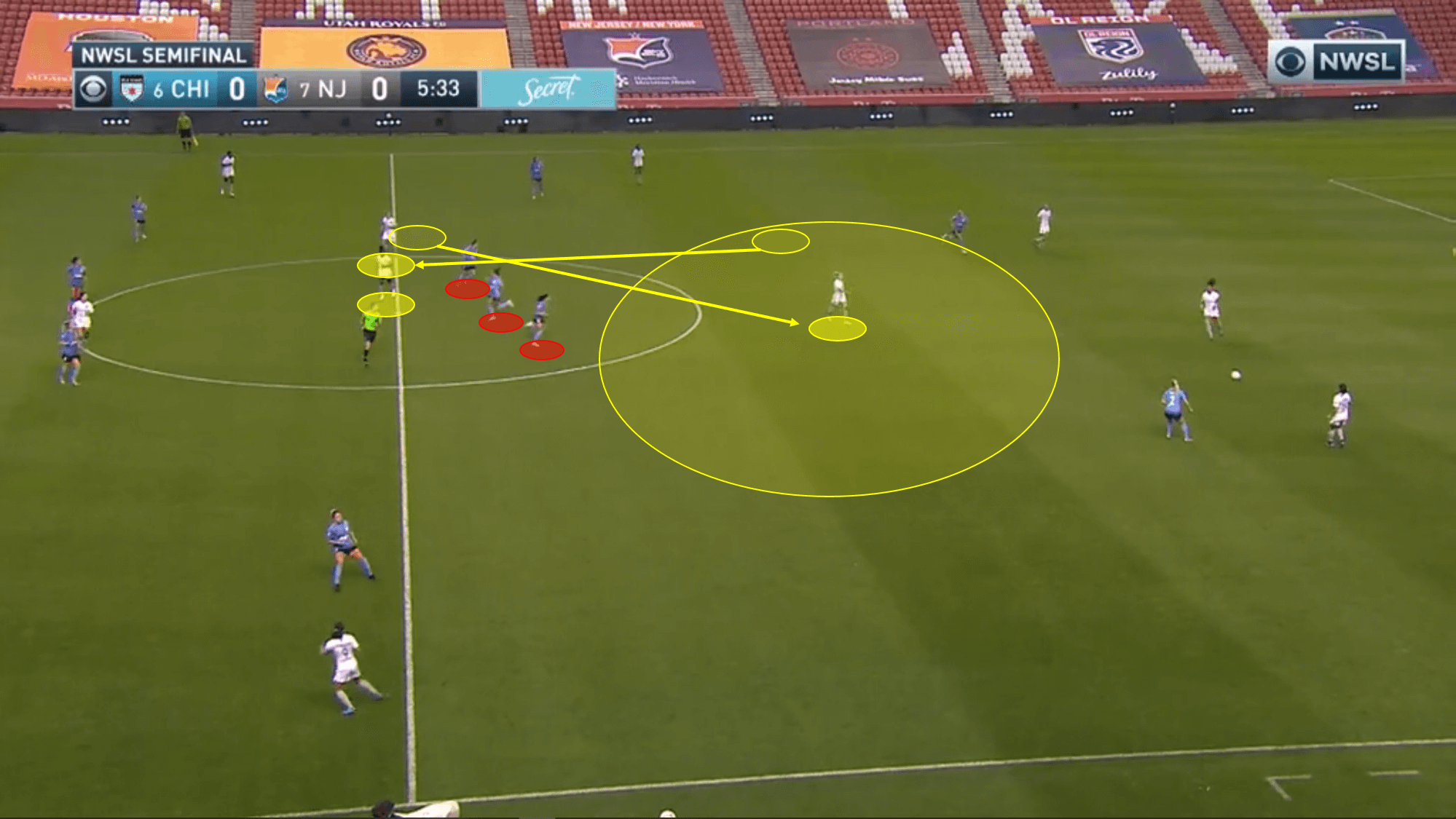
Woldmoe is marked by a Red Stars player and subsequently chooses to move upfield to drag her marker with her. Zerboni recognizes this movement and quickly drops into the space that Woldmoe has just vacated. We can see in the image above that Red Stars are slow to react to Zerboni’s movement and have allowed her to have a large amount of space in the pivot area.
As the Challenge Cup progressed the core midfield players of Cudjoe, Zerboni and Woldmoe became more in tune with each other, with their off-the-ball rotations becoming more fluid and effective with each match played.
Defensive third: Full-back movements
A major and immediate change made by Coombe was the implementation of fullbacks as attacking outlets within Sky Blue’s tactics. Towards the end of the 2019 season, Imani Dorsey was moved from the forward/left-wing position to the left-back role. To complement this, Purce’s arrival from Thorns gave Coombe a new right-back that could move forward in attack as well. We found that Purce was the player sent forward in attack most often.
To enact this tactic Sky Blue first had to shift their defensive line into a back three. This came in the form of Dorsey (or Sabrina Flores) shifting to the left halfspace. Subsequently, centre-backs Gina Lewandowski and Estelle Johnson would shift over to occupy both the central channel and right halfspace.
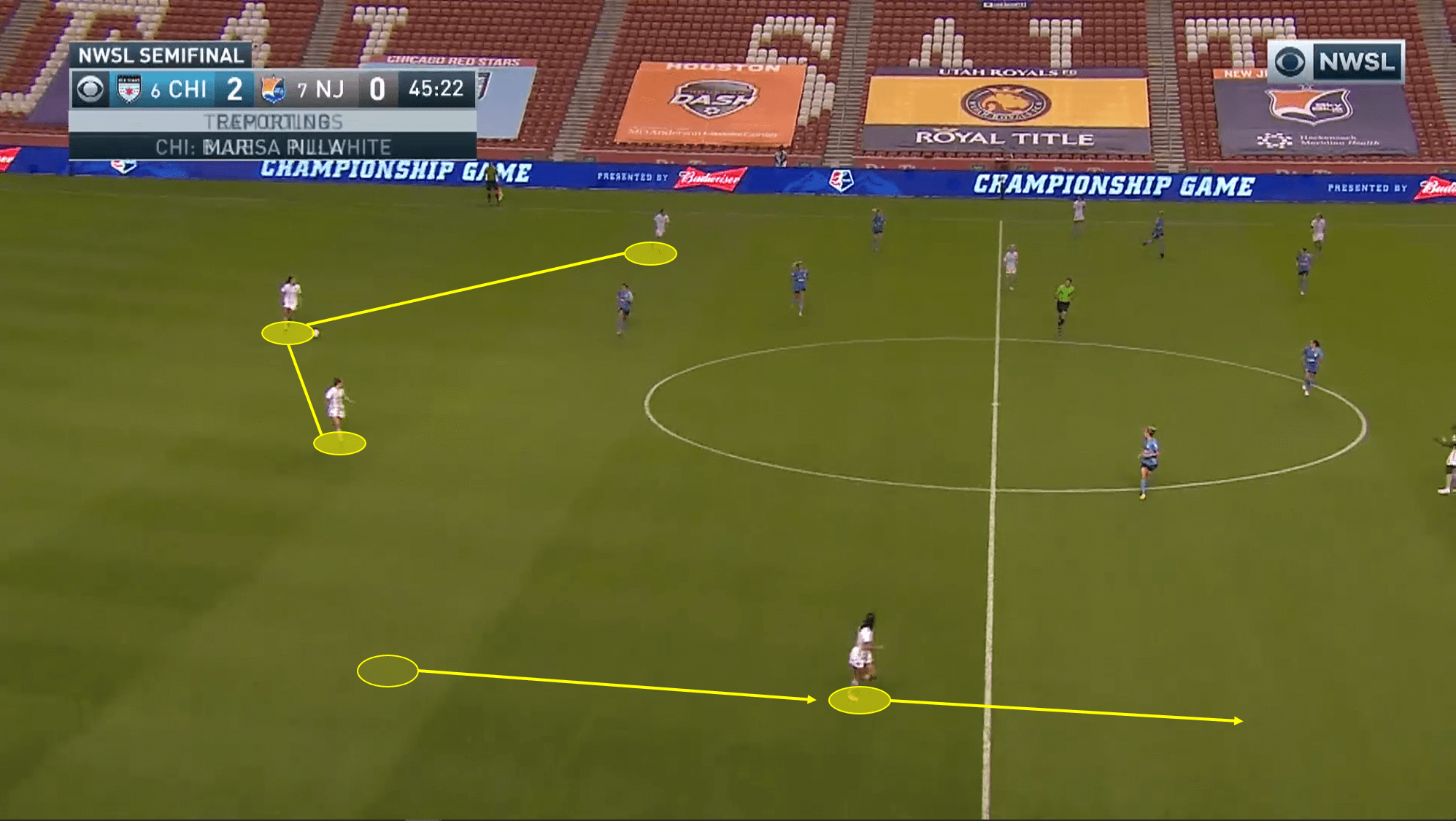
Above, we see this tactic in use in the previously mentioned semi-final match. With adequate defensive coverage of the central areas by the other three defenders, Purce was then able to be released to join the attack. We also saw this particular tactic used more often with each match Sky Blue played.
The fullbacks held another key position when building out of the back as well. When the ball was circulated to a flank, the ball-far full-back would not maintain her width on the flank, but tuck into the halfspace. This movement was executed for two main reasons. A) Although the full-back would not be offering the full width of the field in that moment, she would be able to move to the flank quickly if the ball was released towards the central channel.
B) If Sky Blue lost the ball, the ball-far fullback would be in prime position to stop a counter-attack by the opposition. Typical counter-attack tactics focus on maintaining a presence in both the left and right halfspaces and the central channel. If the ball was lost by Sky Blue while building out of the back, the fullback would not have to track back from the flank, but already be positioned to delay the counter and allow her team to recover.
https://totalfootballanalysi
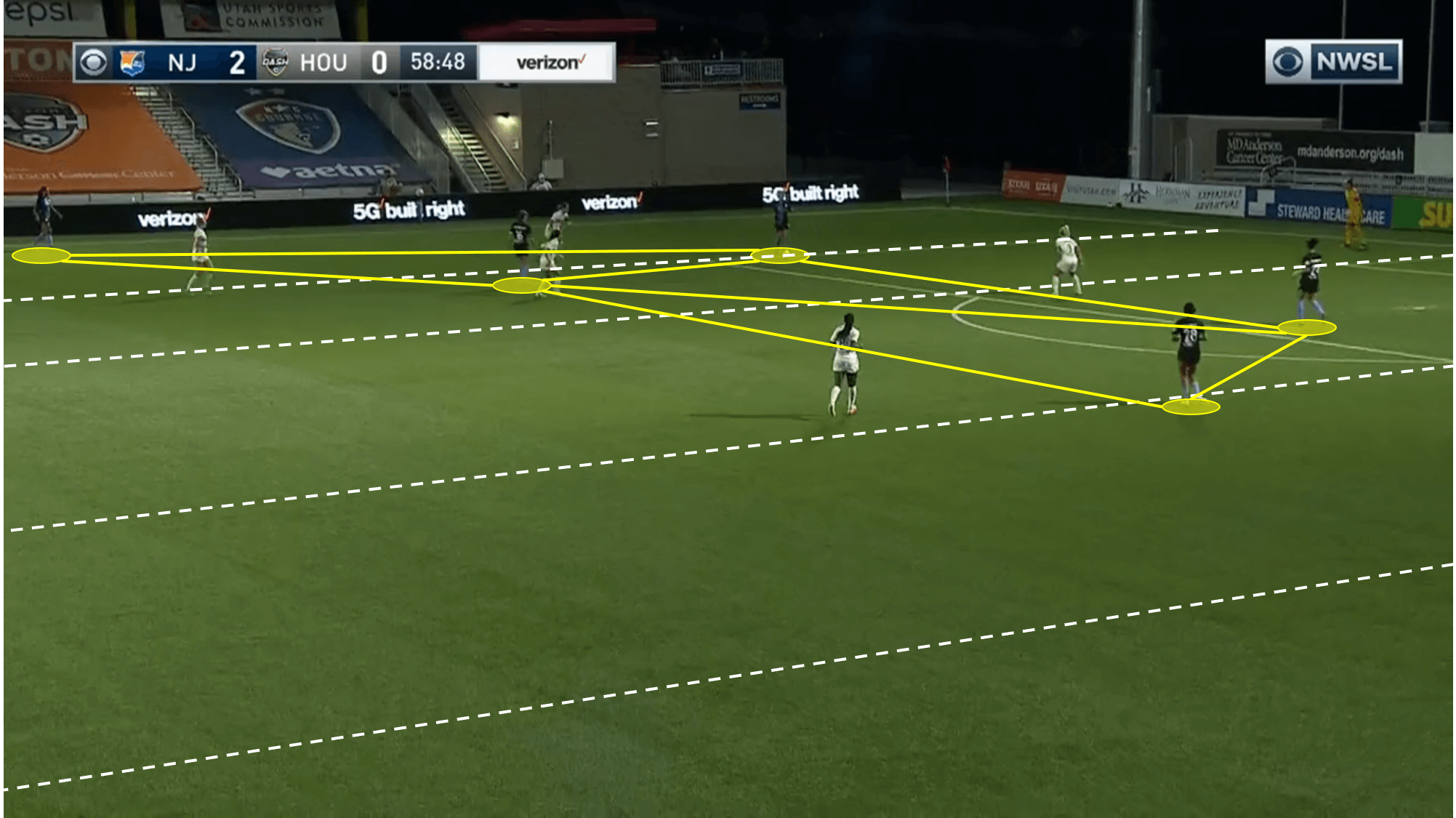
In the image above we see this tactic used against the Houston Dash. As mentioned, Woldmoe has dropped in as the single pivot. Purce is pushing slightly higher than Woldmoe up the right flank to create a forward outlet.
Crucially we see that Dorsey, instead of using the full width of the field and positioning herself on the left flank, has drifted inwards into the left halfspace. We can see that Dorsey has quick and immediate access to positioning in the left flank if needed while simultaneously positioning herself to cancel out any potential Dash counter-attacks.
Attacking the flanks
When attacking the flanks a pattern of positioning by the Sky Blue midfield emerged. Upon entering the middle third of the pitch, two of the three central midfielders would drift over to aid in progressing the ball. Their primary reference point in this moment was the opposition midfield line.
One central midfielder would position herself in front of the opponent midfield line, while another would move behind the said line. While this positioning occurred, the remaining midfielder would remain in the central channel as an outlet to receive the ball and attack the opposing defensive line.
As mentioned earlier, these positions were primary objectives but the use of rotations allowed any Sky Blue midfielder to occupy each location at any given moment. This allowed the midfielders to set up in their initial positions in front of and behind the opposition midfield line and then use previously mentioned positional rotations to aid in ball progression.
In the semi-final match, we saw this occur many times. The ball has circulated to the right flank. Cudjoe has taken up position on the right flank as well, just behind the Red Stars midfield line. Zerboni, who was the pivot, has begun to drift over to offer as a passing option in front of the midfield line. Woldmoe remains in the central channel while simultaneously acting as the eyes and director for the team.
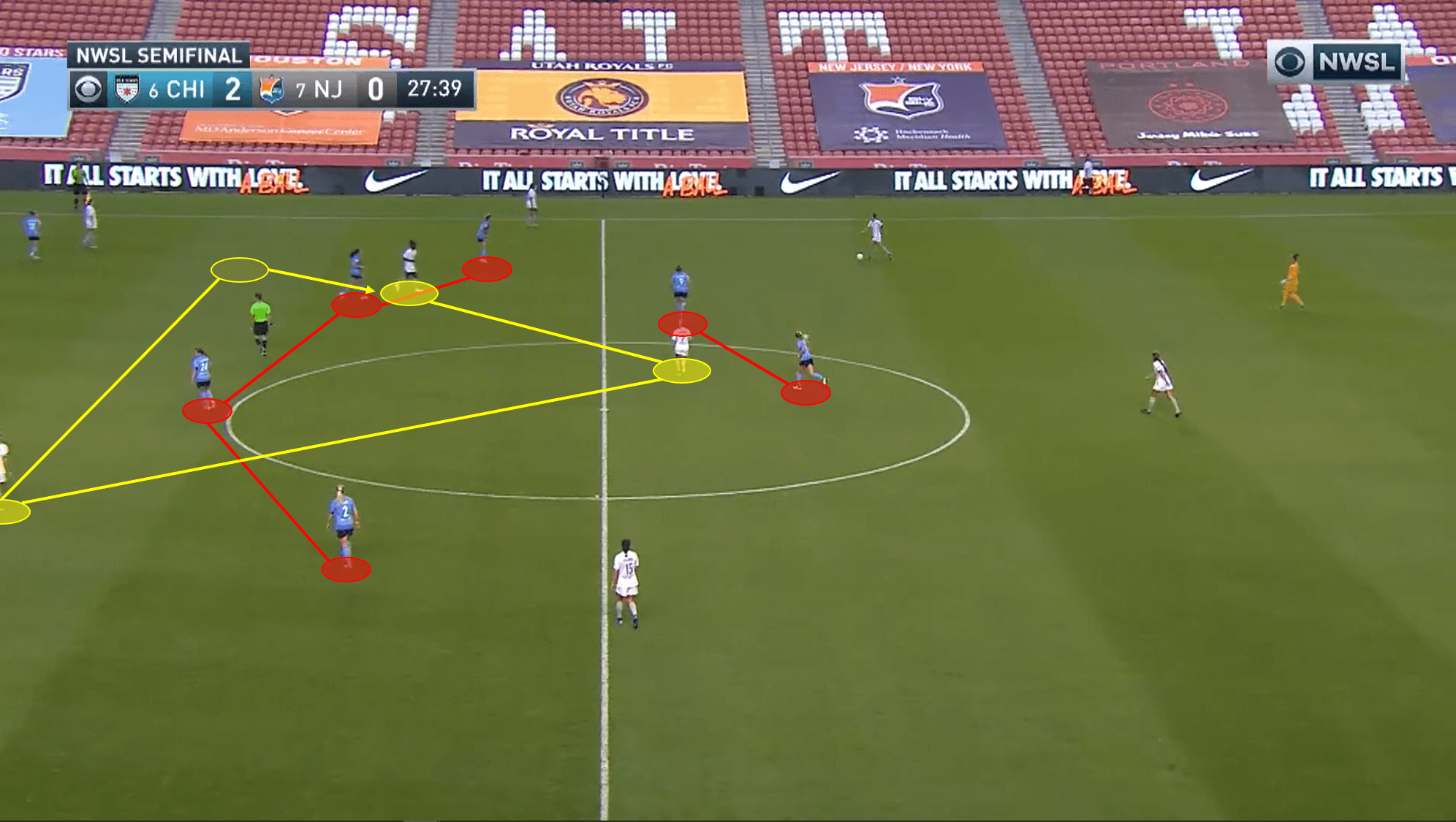
As this initial formation is set up, Cudjoe begins to drop in front of the Red Stars midfield line. Zerboni, recognizing Cudjoe’s movement, quickly pushes forward into the space vacated by Cudjoe. We can see in the image below, that Zerboni has a large amount of attacking space to move into that could quickly become a platform for penetration into the attacking third.
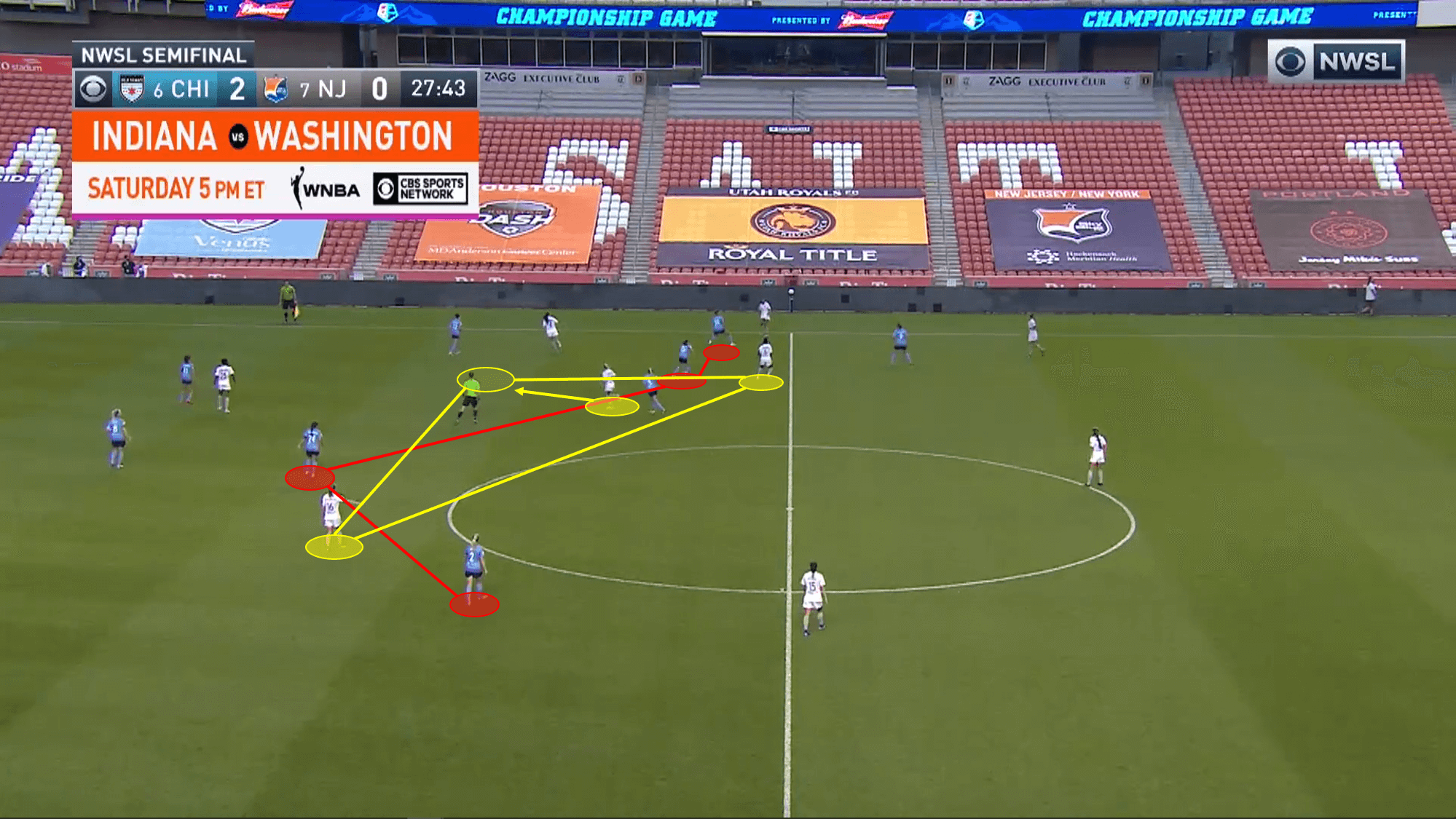
The staggering and rotation of the midfielders helped to allow Sky Blue to penetrate through the middle third to the attacking third of the pitch. This tactic also became more fluid and coordinated with each game Sky Blue played.
Attacking third: drifting Onumonu
When aiming to generate space to create chances on goal, we saw Onumonu make several key movements. Onumonu was constantly found bursting behind the defensive line, dropping to receive, or drifting to the flanks. When drifting to the flanks we found a key positional rotation occurring.
Onumonu, who was usually tightly marked by an opposing centre-back, would drift horizontally towards a given flank. In this moment the Sky Blue winger on that flank would drop from their high position to create space for Onumonu to move into. This dropping movement by the winger would often draw their marking fullback.
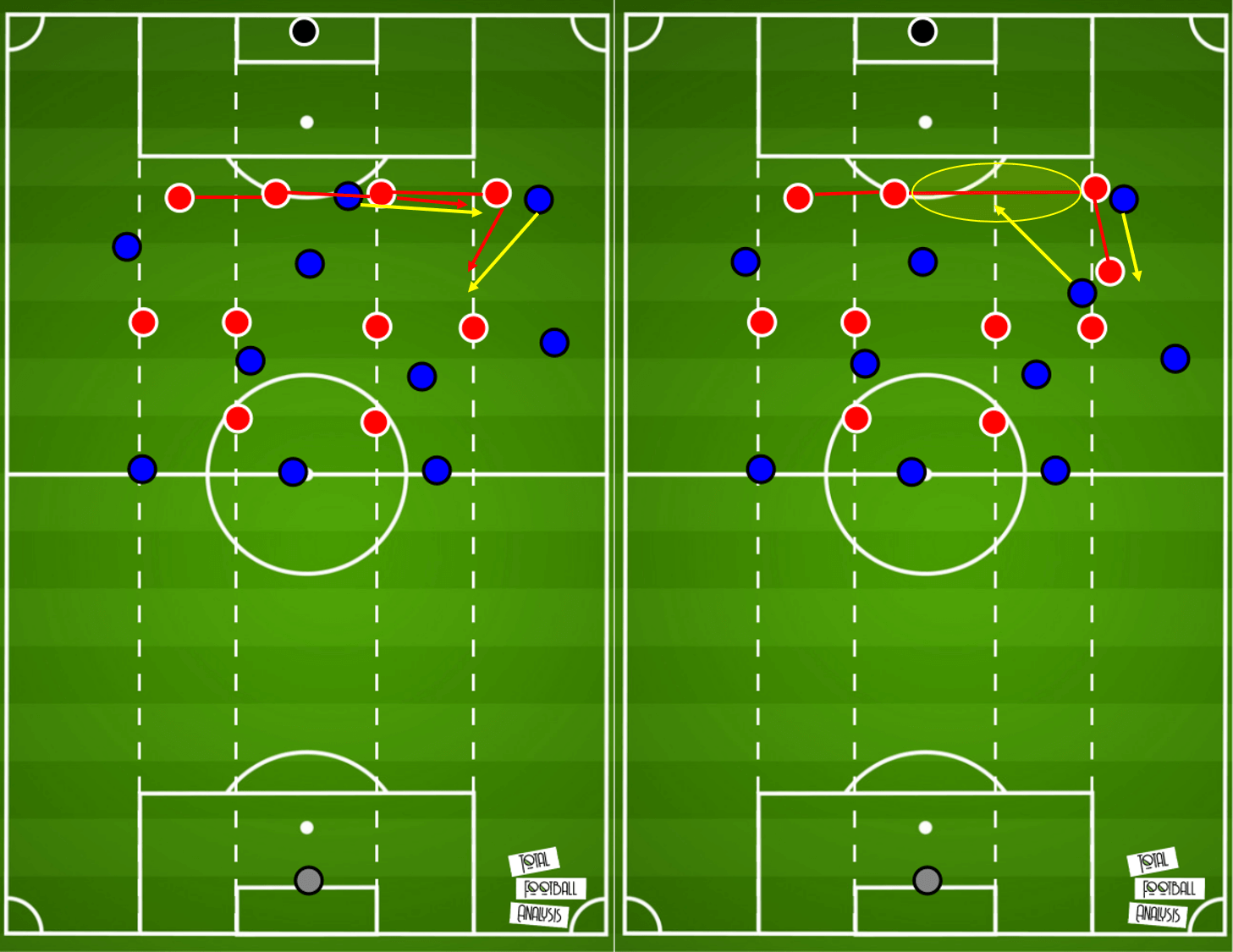
We can see above in the picture on the right, in that moment, the opposing centre-back would be dragged out of her central position and the fullback would be pulled forward. As this occurred, the Sky Blue winger would then push forward into the newly created massive gap between the opponent centre-backs, giving Sky Blue a large area to create chances on goal.
Below we see that Onumonu has drifted towards the left flank. Initially, Julie Ertz tracked her, but wisely, she began to track back to the middle and left the role of covering Onumonu to a midfielder player. As Onumonu drifted to the flank, left-wing Kawasumi drifted centrally and positioned herself to either receive at her feet or burst forward to receive the ball in the newly created gap between the Red Stars centre-backs.
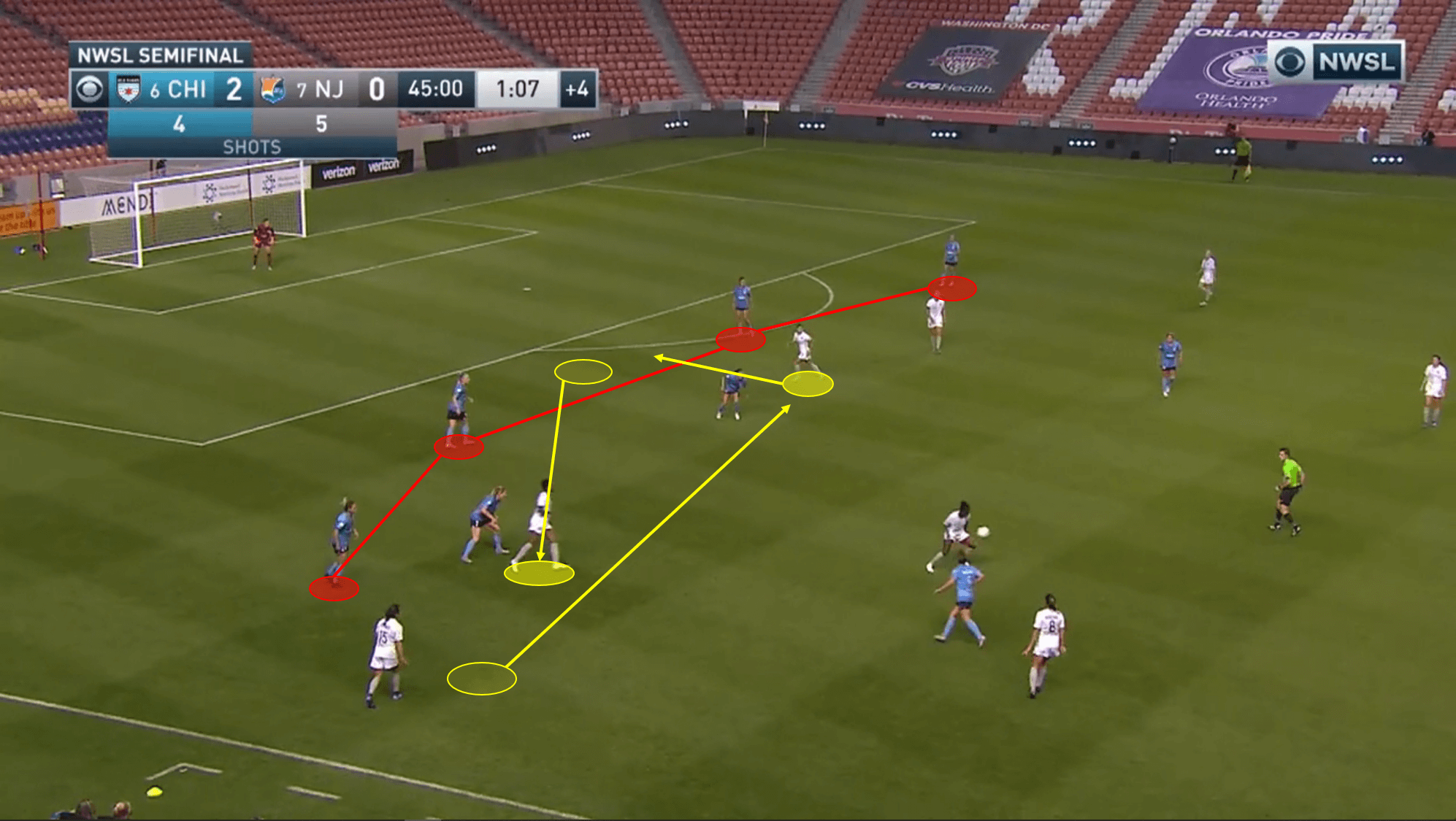
Onumonu tended to find more success in her coordinated movements with right-wing Paige Monaghan. Below we see Monaghan has drifted deeper and inwards while Onumonu floats to the right flank. Because the Houston centre-back has followed Onumonu closely, a massive gap has been created in the Dash defensive line.
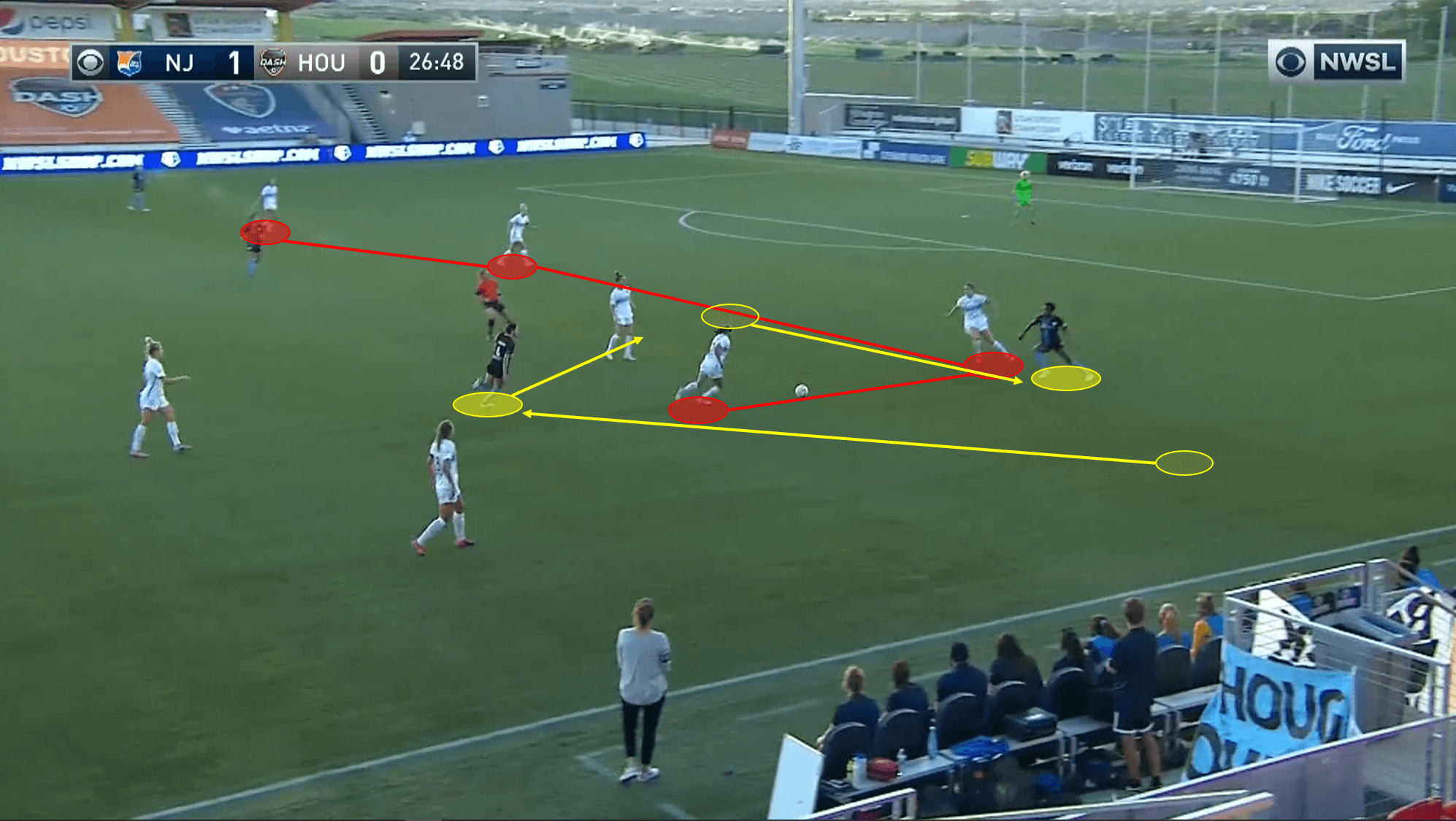
This positional rotation helped Sky Blue to create scoring chances throughout the Challenge Cup. One must wonder if this tactic will become more effective when Mallory Pugh enters the starting XI.
Conclusion
All participating clubs in the 2020 Challenge Cup can say that more time was needed to prepare and the tournament may have been too short for teams to get into a tactical rhythm. This can be said most for Sky Blue, an organization in the middle of immense changes. Given more time, they might have become one of the most feared clubs in the tournament.
Despite a loss in the semi-final, Sky Blue move forward with an extremely positive outlook on the upcoming 2021 campaign. This is amplified by the fact that Sky Blue were missing their top two attackers in Carli Lloyd (who once had a loan spell with Manchester City) and Pugh due to injury. With a new dose of possession-based tactics paired with the return of two potent attackers, we may see Sky Blue crash back into the NWSL playoff picture as a force to be reckoned with.

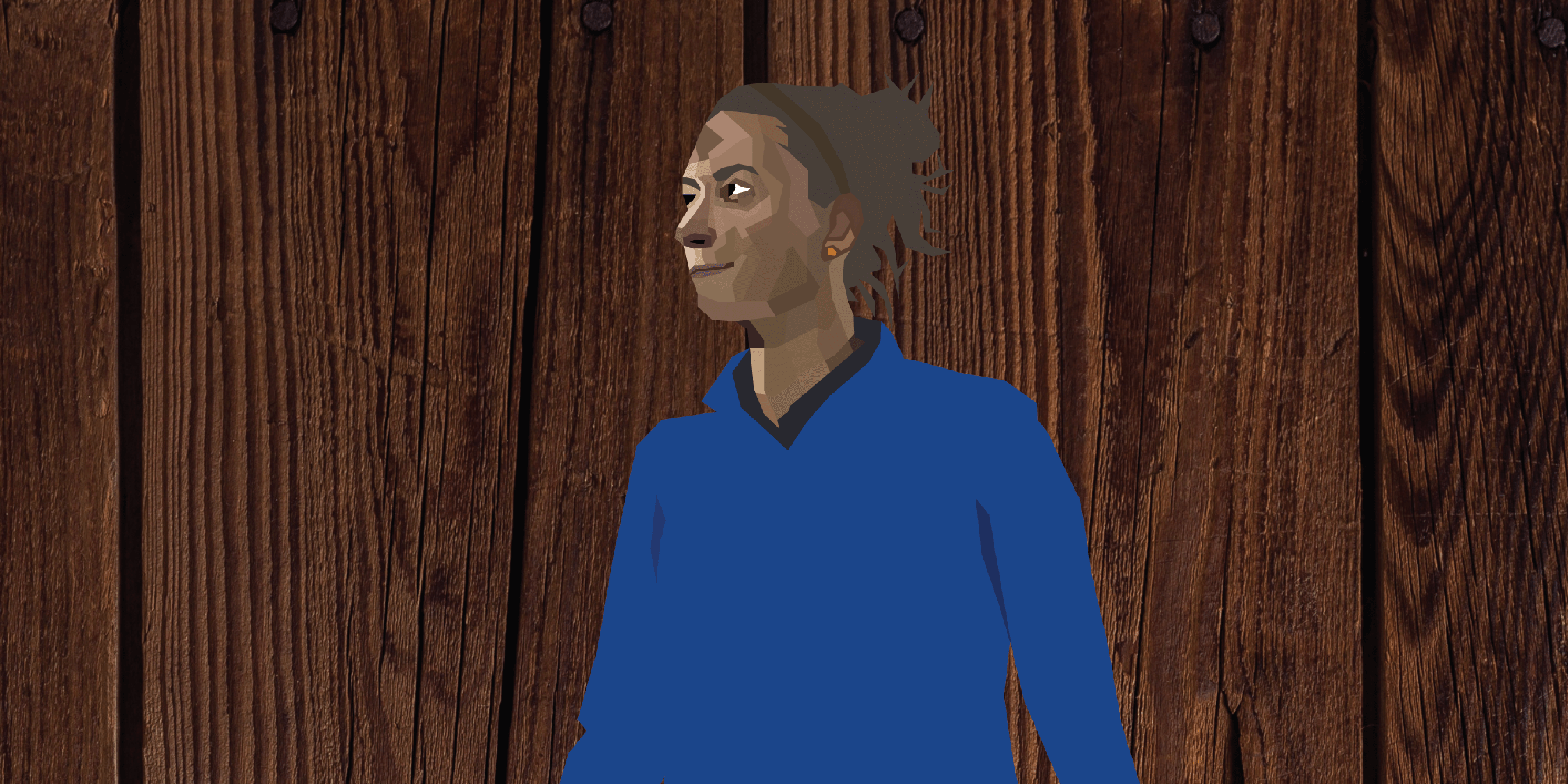



Comments